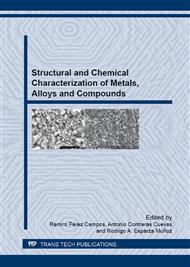p.111
p.119
p.125
p.133
p.139
p.145
p.153
p.163
p.171
Microstructural Behavior during Bonding of Alumina to Niobium by Liquid State Diffusion
Abstract:
The objective of this work was to study various aspects of liquid state diffusion bonding of cylindrical samples of Al2O3 and commercially pure niobium (99.7%) by brazing using a 25 µm thick 70Cu-30Zn (wt%) alloy as joining element. Initially, sintering of alumina powder was carried out in order to produce a 7 mm diameter samples at 1550°C by 120 minutes. Joining experiments were carried out on Al2O3/Cu-Zn/Nb/Cu-Zn/Al2O3 sandwich-like combinations at temperature of 920°C, 950°C and 980°C using different holding times under argon (Ar) atmosphere. The experimental results show a successful joining of alumina to niobium at 950°C and 980°C, however not at 920°C. Joining of Al2O3/Cu-Zn/Nb/Cu-Zn/Al2O3 occurred by the formation of a homogeneous diffusion zone with no interfacial cracking or porosity at the interface. Scanning electron microscopy (SEM) micrographs show the layer formed in the reaction zone. It was observed that the width of the reaction zone increases with bonding temperature and time. Electron probe microanalysis (EPMA) revealed that at any particular bonding temperature, Nb travel into the Cu-Zn joining element forming a circular precipitate phase near to the alumina ceramic.
Info:
Periodical:
Pages:
171-177
Citation:
Online since:
April 2013
Price:
Сopyright:
© 2013 Trans Tech Publications Ltd. All Rights Reserved
Share:
Citation:


